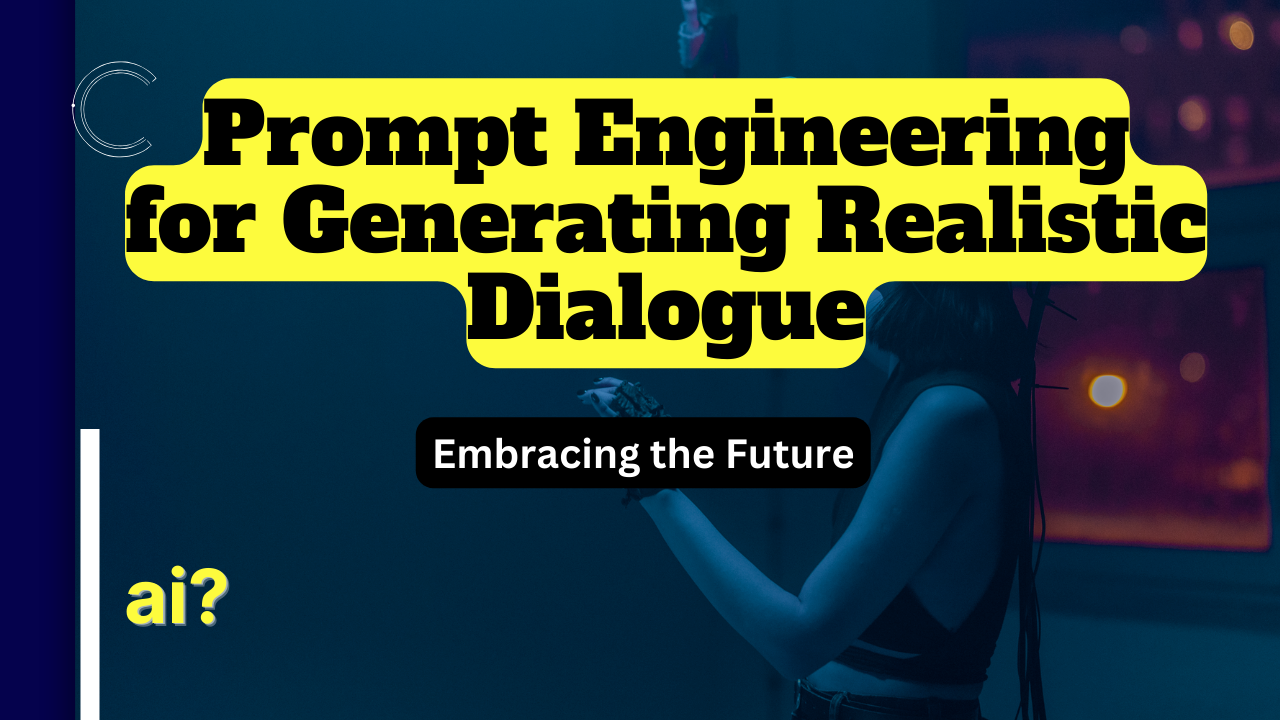Introduction: Prompt Engineering for Generating Realistic Dialogue
The world of artificial intelligence has witnessed remarkable advancements in recent years, and one of the most intriguing applications is dialogue generation. Whether it's chatbots, virtual assistants, or narrative storytelling, the ability to create realistic and engaging conversations with AI is a game-changer. This blog post delves into the art and science of "Prompt Engineering for Generating Realistic Dialogue."
When it comes to dialogue generation, the quality of the interaction largely depends on the prompts given to the AI system. Crafting effective prompts is akin to setting the stage for a captivating conversation. To understand the nuances of prompt engineering, let's embark on a journey to explore the principles, techniques, and ethical considerations that underpin this fascinating field.
Section 1: Understanding Dialogue Generation
Dialogue generation, within the realm of artificial intelligence, refers to the process of creating human-like conversations between machines and users. Imagine interacting with a chatbot that responds like a real person or generating dialogues for characters in a video game. Achieving this level of realism, however, is no small feat.
The Challenges of Realistic Dialogue Generation
Realistic dialogue generation presents several challenges. AI systems must:
Grasp Context: Understand the context of the conversation, including previous messages and user intent.
Maintain Coherence: Ensure that responses follow a logical and coherent flow, just like human conversations.
Emulate Natural Language: Use natural language that sounds human-like, avoiding robotic or stilted language.
Adapt to User Style: Adjust responses to match the user's communication style and tone.
These challenges highlight the crucial role of prompt engineering. The prompts serve as instructions to the AI system, guiding it in generating appropriate and contextually relevant responses.
Section 2: Key Principles of Effective Prompt Engineering
At the heart of prompt engineering lies a set of key principles that govern the creation of effective prompts for dialogue generation.
Clarity and Specificity
An effective prompt is clear and specific about what is expected in the response. Vague or ambiguous prompts can lead to confusing or irrelevant replies. Consider the following prompts:
Vague Prompt: "Tell me about dogs."
Specific Prompt: "Describe the characteristics and behavior of Golden Retrievers."
The specific prompt yields a more focused and informative response.
Contextualization
Context is crucial in dialogue generation. Effective prompts should provide the necessary context for the AI system to understand the user's query or the ongoing conversation. For instance:
Without Context: "Translate this sentence."
With Context: "Translate the following English sentence into French: 'Hello, how are you?'"
Providing context ensures that the AI system knows what is expected and can generate context-aware responses.
Relevance and Engagement
Prompts should be designed to elicit responses that engage users and maintain their interest. Crafting prompts that spark curiosity, emotion, or relevance to the user's query can lead to more compelling conversations.
Engaging Prompt: "Imagine you're a tour guide in Paris. Describe the top three must-visit attractions for tourists."
This prompt invites the AI system to create an engaging narrative, enhancing the user's experience.
Adaptation and Iteration
The art of prompt engineering often involves adaptation and iteration. Prompt designers may need to adjust prompts based on user feedback and the AI system's performance. A/B testing, where different prompts are compared, can help refine and optimize dialogue generation.
These principles lay the foundation for effective prompt engineering, but there's much more to explore in this intricate field. In the following sections, we'll delve deeper into leveraging language models, crafting realistic dialogue prompts, testing and fine-tuning prompts, and exploring real-world applications of prompt engineering for dialogue generation.
Frequently Asked Questions (FAQ) Prompt Engineering for Generating Realistic Dialogue
Q1: What is the role of prompts in dialogue generation?
A1: Prompts in dialogue generation act as instructions to the AI system, guiding it in generating contextually relevant and coherent responses. They set the stage for the conversation and significantly impact the quality of the interaction.
Q2: How do you create prompts that sound natural and human-like?
A2: Crafting prompts that sound natural involves using clear, context-rich language. Avoid overly technical or ambiguous phrasing. Think about how a human would initiate a similar conversation and use that as a guide.
Q3: Can prompts be tailored to match a specific user or audience?
A3: Absolutely. Effective prompt engineering includes adapting prompts to suit the user's communication style, tone, and preferences. Personalization can enhance the user's experience.
Q4: What challenges are associated with dialogue generation?
A4: Realistic dialogue generation faces challenges such as context understanding, coherence maintenance, natural language emulation, and adapting to user style. Overcoming these challenges is a key focus of prompt engineering.
Q5: How can I test and iterate prompts for better dialogue generation?
A5: Testing and iteration involve experimenting with different prompts and analyzing the quality of the generated responses. A/B testing, user feedback, and continuous refinement are essential for improving prompt effectiveness.
Q6: Are there ethical considerations in prompt engineering?
A6: Yes, ethical considerations play a significant role. Prompt designers must ensure that prompts adhere to ethical guidelines, avoid biases, and prioritize user privacy and safety.
Q7: What are some real-world applications of dialogue generation with effective prompts?
A7: Dialogue generation with effective prompts finds applications in chatbots, virtual assistants, video games, customer support, and content creation. It's a versatile technology with a wide range of uses.
These FAQs provide insights into the fundamental aspects of prompt engineering and dialogue generation. If you have more specific questions or need further information, feel free to reach out, and we'll be happy to assist you.
Written by: Md Muktar Hossain
























